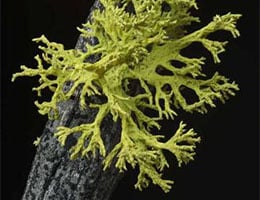 The Greek word leichḗn came to Latin as lichen , which in our language led to lichen . This is the name given to an organism that arises from the symbiosis of unicellular algae with fungi .
The Greek word leichḗn came to Latin as lichen , which in our language led to lichen . This is the name given to an organism that arises from the symbiosis of unicellular algae with fungi .
symbiosis
This symbiosis occurs when the fungus absorbs nutrients from the algae. For this, it is common for the fungus to penetrate the cells of the alga through the haustoria : the tips of the hyphae (the network of filaments that are part of the structure of the fungus). Once the symbiosis has taken place, the lichen feeds on the substances that the alga synthesizes through photosynthesis.
Lichens develop in humid environments , growing as crusts or sheets on tree bark or on stones. Depending on the type of association established by algae and fungi , they present different structural characteristics.
Thanks to their resistance, lichens can develop the colonization of different types of ecosystems. Symbionts can carry out photosynthesis like algae and, in turn, are protected from the sun's radiation like fungi. With the so-called lichen substances, meanwhile, lichens can use light and water efficiently.
Lichens have been found in deserts and polar regions , for example. Their ability to adapt allows them to survive and develop in multiple habitats. Experiments were even carried out that showed that lichens can survive in outer space without protection.
It is important to mention that the taxonomic classification of lichens is often a matter of discussion. Specialists have included these organisms in different groups throughout history.
Regarding the history of lichens, it should be noted that their fossil remains appear very infrequently. In the field of paleobotany , the discipline that merges botany and paleontology with the aim of studying the remains of ancient plants, it is known that an incomplete record is not enough to teach us the reality of flora in a remote era .
 When traces are scarce, therefore, they are used to estimate at what time in history the species to which they belong appeared. This research is carried out using the knowledge and techniques of phylogeny (the kinship relationship between species or taxa). In this particular case, that of lichens, we are looking for the point in time at which a fungus and an algae went through the aforementioned symbiosis for the first time.
When traces are scarce, therefore, they are used to estimate at what time in history the species to which they belong appeared. This research is carried out using the knowledge and techniques of phylogeny (the kinship relationship between species or taxa). In this particular case, that of lichens, we are looking for the point in time at which a fungus and an algae went through the aforementioned symbiosis for the first time.
To date, Thuchomyces lichenoides is considered the oldest lichen. It is believed that it appeared in the Precambrian, the first stage in the history of our planet and also the longest. It was a marine species, according to the sediments in which its fossils were found. Scientists have not been able to determine if there was a photobiont linked to this lichen, although they did identify its mycobiont.
At the Rhynie Chert site, on the other hand, a fossil was found that they have called Winfrenatia reticulata , whose scientific value is incalculable given that it is located in the Devonian period , which corresponds to the Paleozoic Era .
Reproduction of lichens can occur asexually through portions of thallus from both bionts. This term, which is also known as "false tissue", is defined as the group of leaves, stem and root of a plant; In the case of algae, on the other hand, it is made up of laminae, haptera and stipe. This asexual reproduction takes place in the so-called "taline fragmentation." It can also be done through the soredia and isidia, two specialized structures.
